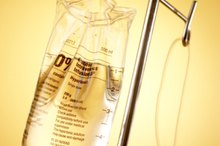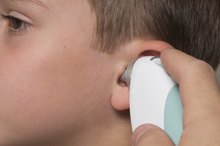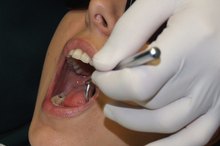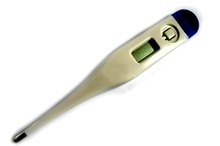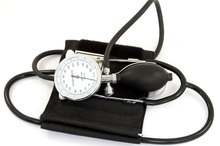The Difference Between Oral & Rectal Thermometers
There are three main ways to take a temperature--orally, rectally and axillarily. This is done by inserting the thermometer in the mouth, anus or under the armpit. A rectal thermometer may be used orally and axillary, but oral and axillary thermometers should not be used rectally due to a key difference in how they are constructed. Whatever the design of the thermometer, any thermometer that has been in a rectum should not be used orally due to risk of illness from harmful bacteria remaining on the thermometer.
Bulb Shape
Rectal tissues are delicate and easily torn 2. Rectal thermometers have a short, blunt, slightly rounded tip that reduces the risk of puncture or tearing of the rectum. Thermometers designed specifically for oral use have longer, thinner tip. The diameters of the thermometers may or may not be different. The longer tip exposure gives the sensor or mercury a larger surface to read from, which gives a quicker, more accurate result, so it is best to use an oral thermometer in the mouth instead of a rectal one.
- Rectal tissues are delicate and easily torn 2.
- The longer tip exposure gives the sensor or mercury a larger surface to read from, which gives a quicker, more accurate result, so it is best to use an oral thermometer in the mouth instead of a rectal one.
Color Coding
How to Change the Mode on a Safety 1st Digital Thermometer
Learn More
To reduce the chance of a using the wrong thermometer, manufacturers color the stem end. Oral thermometers are colored blue, while rectal thermometers are colored red. The way to remember this is "red" and "rectum" both start with the letter "r." The difference in color along with the shape of the bulb helps prevent a rectal thermometer from being mistaken for an oral one, eliminating the potential spread of fecal bacteria into the mouth.
- To reduce the chance of a using the wrong thermometer, manufacturers color the stem end.
- The way to remember this is "red" and "rectum" both start with the letter "r." The difference in color along with the shape of the bulb helps prevent a rectal thermometer from being mistaken for an oral one, eliminating the potential spread of fecal bacteria into the mouth.
Temperature Indicators
One other difference between rectal and oral thermometers is the location of the line or indicator showing “normal” temperature. There is a 1 degree difference in the ideal oral and rectal temperatures. Rectal temperature should be around 99.6 degrees. Oral temperature should be about a degree cooler--98.6 degrees. Thermometers dedicated for a particular use note this difference so that the user can get the most accurate reading.
- One other difference between rectal and oral thermometers is the location of the line or indicator showing “normal” temperature.
- There is a 1 degree difference in the ideal oral and rectal temperatures.
Related Articles
References
- SweetHaven Publishing Services: Taking Vital Signs
- Sulaski Wyckoff A. Thermometer use 101. AAP News. 2009;30(11);29. doi:10.1542/aapnews.20093011-29a
- El-Radhi AS. Determining fever in children: the search for an ideal thermometer. Br J Nurs. 2014;23(2):91-94. doi:10.12968/bjon.2014.23.2.91
- Geijer H, Udumyan R, Lohse G, Nilsagård Y. Temperature measurements with a temporal scanner: systematic review and meta-analysis. BMJ Open. 2016;6(3):e009509. doi:10.1136/bmjopen-2015-009509
- U.S. Environmental Protection Agency. Mercury thermometers. Updated June 26, 2018.
- Stanford Children's Health, Lucile Packard Children's Hospital. Fever in children.
- American Academy of Pediatrics: healthychildren.org. How to take a child's temperature. Updated November 21, 2015.
- Obermeyer Z, Samra JK, Mullainathan S. Individual differences in normal body temperature: longitudinal big data analysis of patient records. BMJ. 2017;359:j5468. doi:10.1136/bmj.j5468

